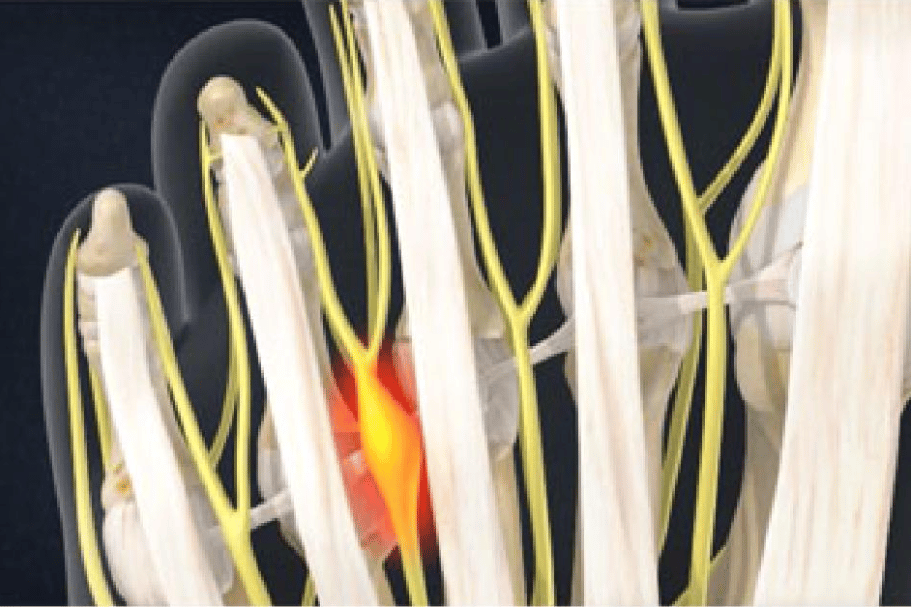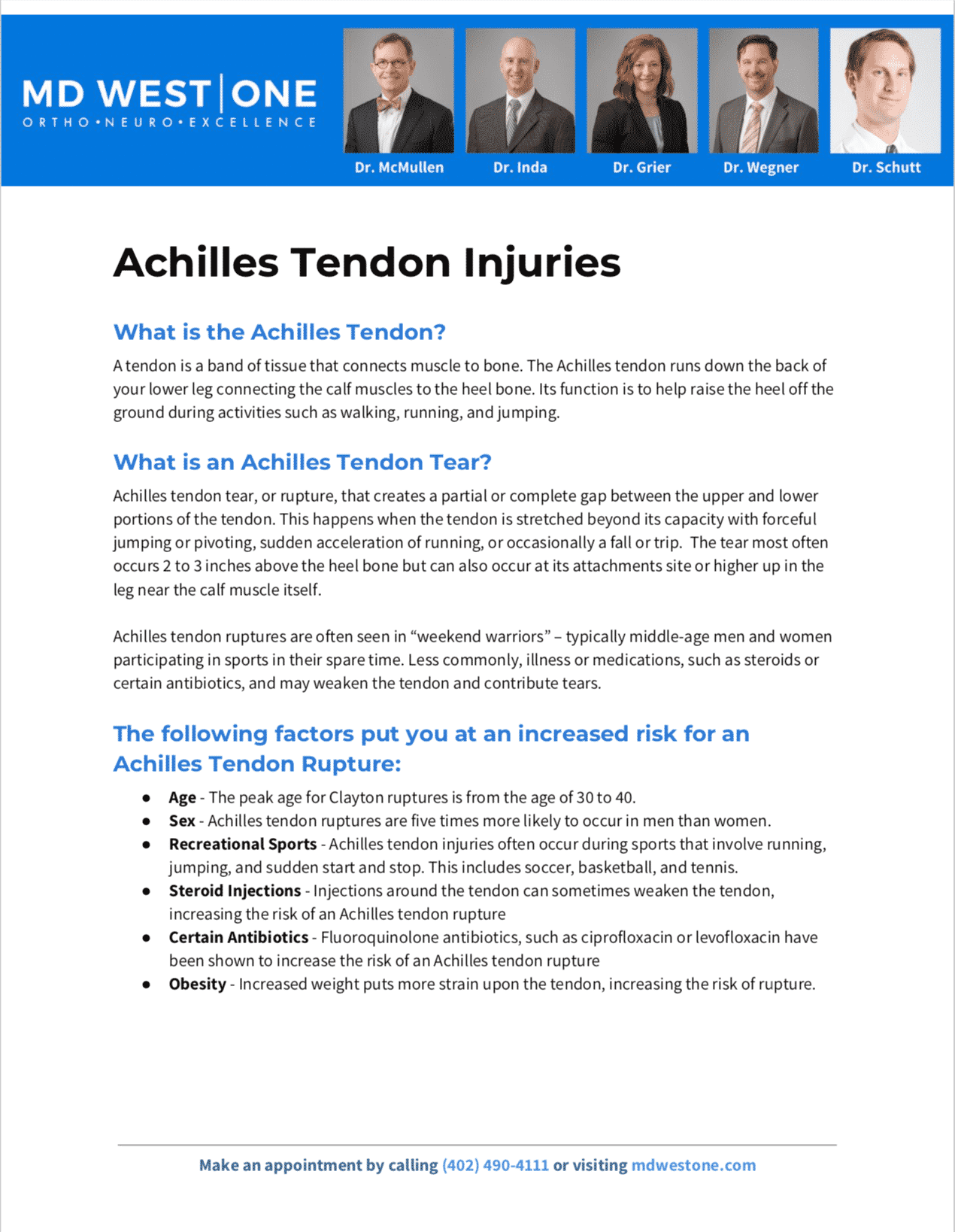Removal of Morton's Neuromas
Morton's Neuroma is a painful foot condition that causes the tissue around the nerves leading to your toes to thicken around the ball of your foot. It may feel like you are perpetually standing on a pebble. You may experience a sharp and burning pain near the back of the afflicted foot.
The discomforting condition is benign. However, Morton's neuroma can cause your toes to sting, burn, or feel numb. Typically, the condition afflicts the area between your third and fourth toes, and it commonly develops for middle-aged people, especially women.
Symptoms
The Omaha Foot & Ankle Specialists at MD West ONE are able to properly diagnose the condition, Morton's Neuroma, which may lead to the removal of the nerves in the ball of the foot. If you have the following symptoms, you may want to make an appointment with one of our Board Certified Specialists.
- Burning pain in the ball of the foot. Some people describe the pain as if they are perpetually standing on a marble in their shoe.
- Numbness in the toes. Walking may be painful and difficult. However, there will not be noticeable swelling in the foot. Some people report a tingling feeling.
- Sharp pain — or a dull irritation — in the nerve tissue connecting the third and fourth toes.
Symptoms often appear gradually, and pain will begin to intensify during athletic ventures or while wearing narrow-toed shoes. As the neuroma enlarges, the symptoms will become more chronic and uncomfortable.
Before recommending surgery, your healthcare provider may use non-surgical treatment options to help your symptoms, such as:
- Activity modification
- Anti-inflammatory medications
- Corticosteroid injection
- Changing your footwear like avoiding wearing shoes that are narrow, tight, or high heels
- Trying custom shoe inserts
- Icing the inflamed area
- Using pads at the ball of your foot

Surgical Procedure
If conservative approaches are not helping your pain, surgery may be recommended to remove the ball of nerves. To begin the procedure, you are put under anesthesia. Once ready, the surgeon makes a small incision at the top of the foot to remove the portion of the nerve. While doing so, they may need to also release tight ligaments surrounding the nerve area.
Possible Complications from Morton’s Neuroma Surgery
All surgeries have risks associated with them. The main risks of Morton’s Neuroma Surgery include:
- Nerve Problems – The web space from which the nerve is removed will be permanently numb which does not bother most patients but the web space should subsequently be checked regularly by the patient when bathing to ensure no skin problems as they will not have a protective sensation here.
- Swelling - Swelling will decrease after surgery but will be apparent for up to 6-9 months
- Continuing symptoms
- Infection
- Wound problems
- Scar sensitivity
- Complex Regional Pain Syndrome (CRPS)
- Deep Vein Thrombosis (DVT), also referred to as a blood clot
Post Operative Care
The incision is closed after the nerve removal and many patients are able to go home that same day. Your foot will be bandaged for about two weeks after the surgery and you will need to use an orthopedic boot to protect the incision site and let it heal. After about two to three weeks, you will likely be able to return to physical activity starting with low-impact sessions and gradually moving your way up to your activity levels before the surgery.
Adequate padding on the metatarsal arch will support and lessen the pressure on the foot nerves, decreasing compression while walking. Icing the afflicted area will reduce swelling, and the patient should refrain from athletic activities until the condition improves.
Oral nonsteroidal anti-inflammatory drugs (NSAIDs), such as ibuprofen, will relieve pain, while corticosteroid medication can reduce the swelling and inflammation of the nerve, bringing some relief. Several studies have shown that a combination of roomier, more comfortable shoes, nonsteroidal anti-inflammatory medication, custom foot orthoses, and cortisone injections provide relief in over 80% of people with Morton's Neuroma.
When should you contact your healthcare provider or go to an emergency room?
After surgery if you are experiencing any of the following symptoms, you should contact your healthcare provider or go to the emergency room:
- Uncontrolled pain
- Increased swelling
- Signs of infection such as fever, chills, redness or your incision is draining
Meet MD West ONE's foot and ankle specialists and learn more about how they treat the removal of Morton's Neuromas.
AMERICAN ORTHOPAEDIC FOOT & ANKLE SOCIETY
All of the foot and ankle surgeons in the practice are recognized members of the American Orthopaedic Foot & Ankle Society. It is the oldest and most prestigious medical society dedicated to the foot and ankle. The mission of the society is to advance science and practice of foot and ankle surgery through education, research, and advocacy on behalf of patients and practitioners. These physicians dedicate their time and energy to improving the patient experience and their knowledge in their field. For more information visit http://www.aofas.org.
MD West ONE Foot & Ankle Specialists:
The Foot & Ankle Specialists are all Board Certified and Fellowship-Trained, meaning they’ve focused their education, training and research on orthopaedic surgery of the foot and ankle.






